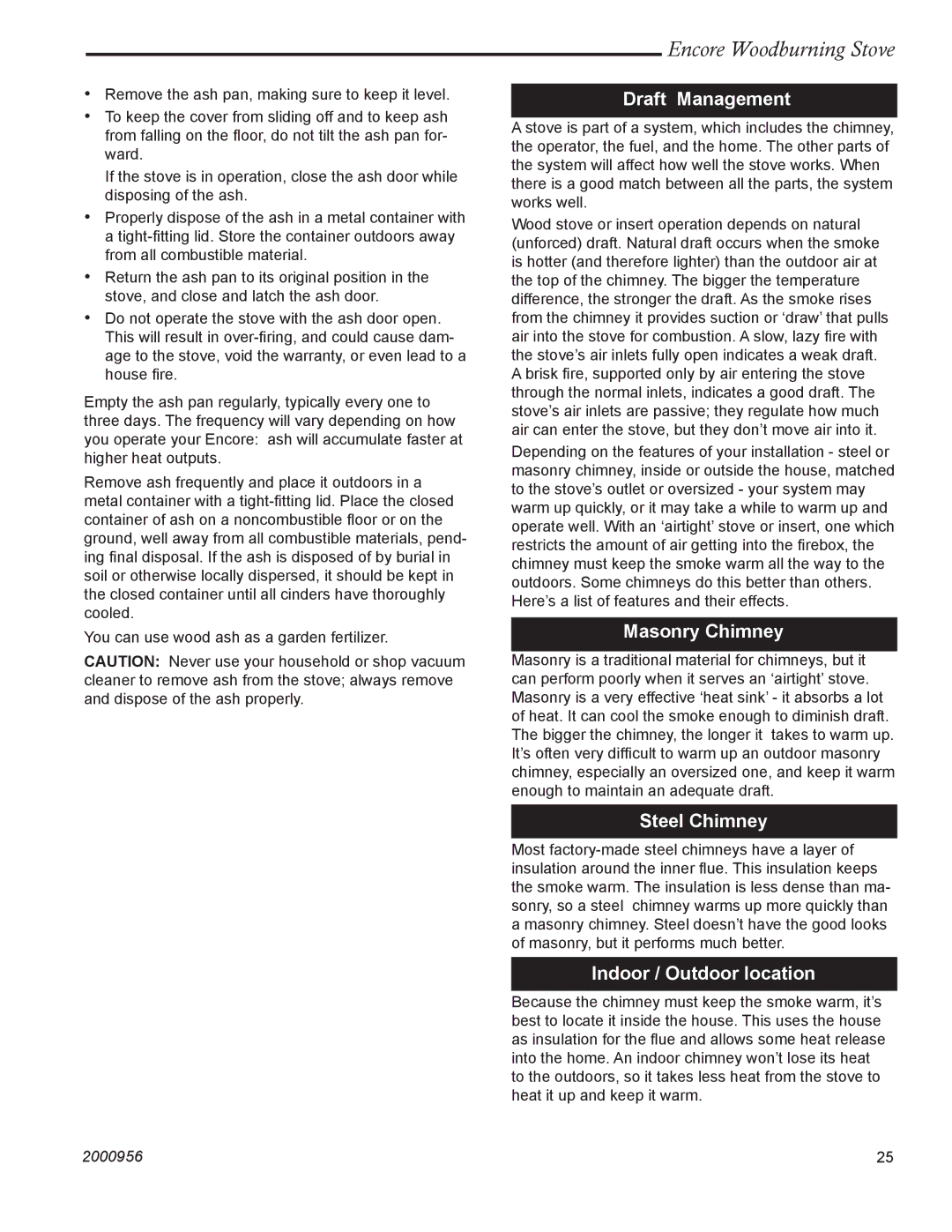
•Remove the ash pan, making sure to keep it level.
•To keep the cover from sliding off and to keep ash from falling on the floor, do not tilt the ash pan for- ward.
If the stove is in operation, close the ash door while disposing of the ash.
•Properly dispose of the ash in a metal container with a
•Return the ash pan to its original position in the stove, and close and latch the ash door.
•Do not operate the stove with the ash door open. This will result in
Empty the ash pan regularly, typically every one to three days. The frequency will vary depending on how you operate your Encore: ash will accumulate faster at higher heat outputs.
Remove ash frequently and place it outdoors in a metal container with a
You can use wood ash as a garden fertilizer.
CAUTION: Never use your household or shop vacuum cleaner to remove ash from the stove; always remove and dispose of the ash properly.
Encore Woodburning Stove
Draft Management
A stove is part of a system, which includes the chimney, the operator, the fuel, and the home. The other parts of the system will affect how well the stove works. When there is a good match between all the parts, the system works well.
Wood stove or insert operation depends on natural (unforced) draft. Natural draft occurs when the smoke is hotter (and therefore lighter) than the outdoor air at the top of the chimney. The bigger the temperature difference, the stronger the draft. As the smoke rises from the chimney it provides suction or ‘draw’ that pulls air into the stove for combustion. A slow, lazy fire with the stove’s air inlets fully open indicates a weak draft. A brisk fire, supported only by air entering the stove through the normal inlets, indicates a good draft. The stove’s air inlets are passive; they regulate how much air can enter the stove, but they don’t move air into it.
Depending on the features of your installation - steel or masonry chimney, inside or outside the house, matched to the stove’s outlet or oversized - your system may warm up quickly, or it may take a while to warm up and operate well. With an ‘airtight’ stove or insert, one which restricts the amount of air getting into the firebox, the chimney must keep the smoke warm all the way to the outdoors. Some chimneys do this better than others. Here’s a list of features and their effects.
Masonry Chimney
Masonry is a traditional material for chimneys, but it can perform poorly when it serves an ‘airtight’ stove. Masonry is a very effective ‘heat sink’ - it absorbs a lot of heat. It can cool the smoke enough to diminish draft. The bigger the chimney, the longer it takes to warm up. It’s often very difficult to warm up an outdoor masonry chimney, especially an oversized one, and keep it warm enough to maintain an adequate draft.
Steel Chimney
Most
Indoor / Outdoor location
Because the chimney must keep the smoke warm, it’s best to locate it inside the house. This uses the house as insulation for the flue and allows some heat release into the home. An indoor chimney won’t lose its heat to the outdoors, so it takes less heat from the stove to heat it up and keep it warm.
2000956 | 25 |
